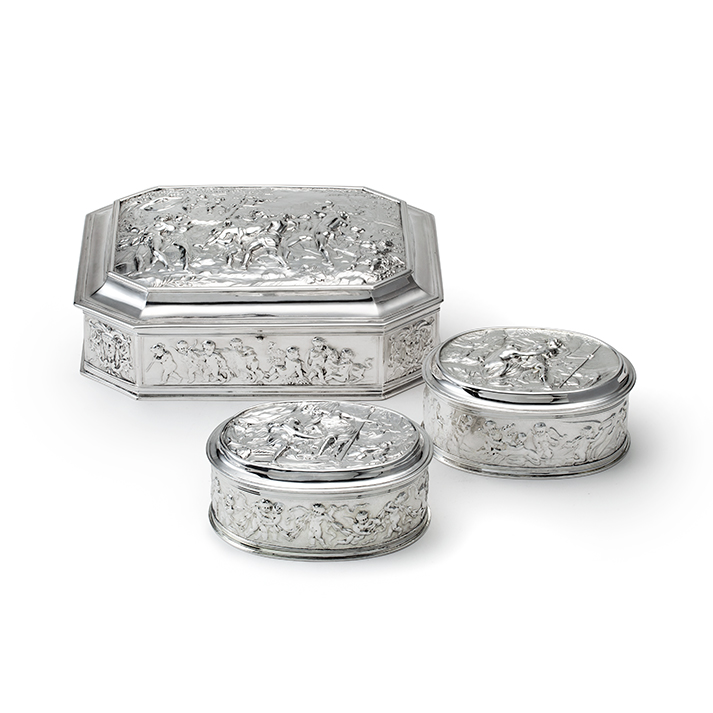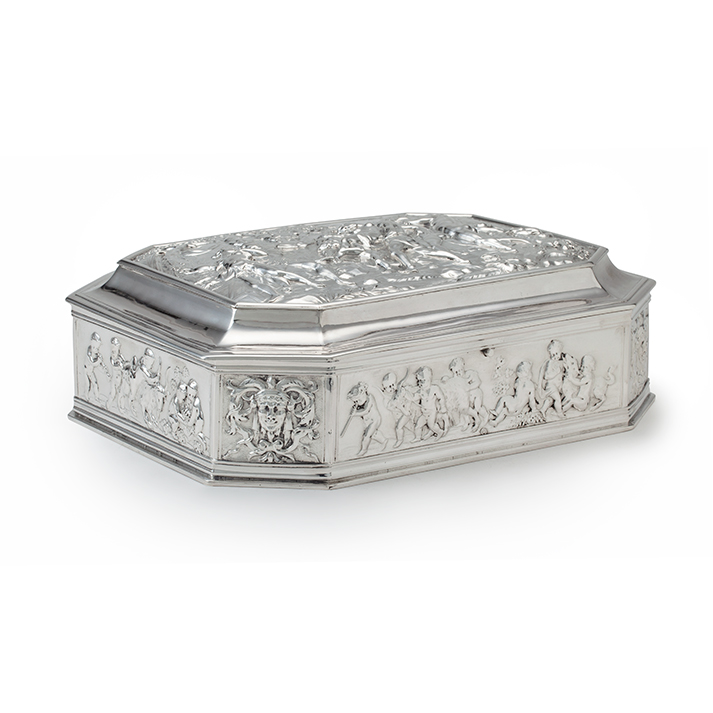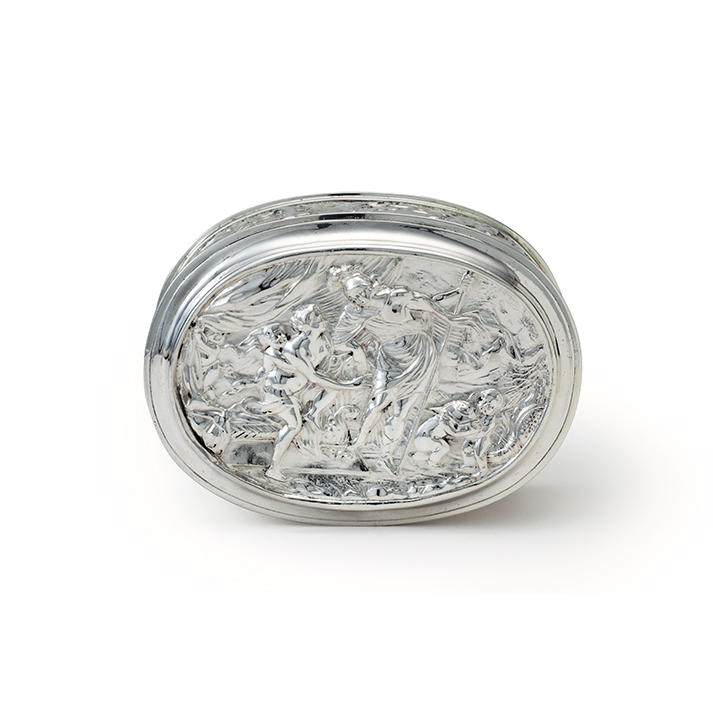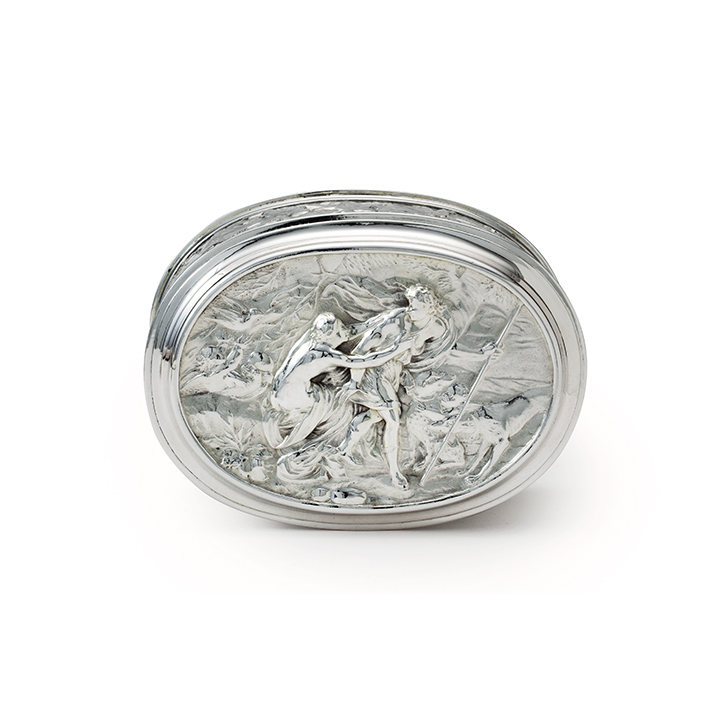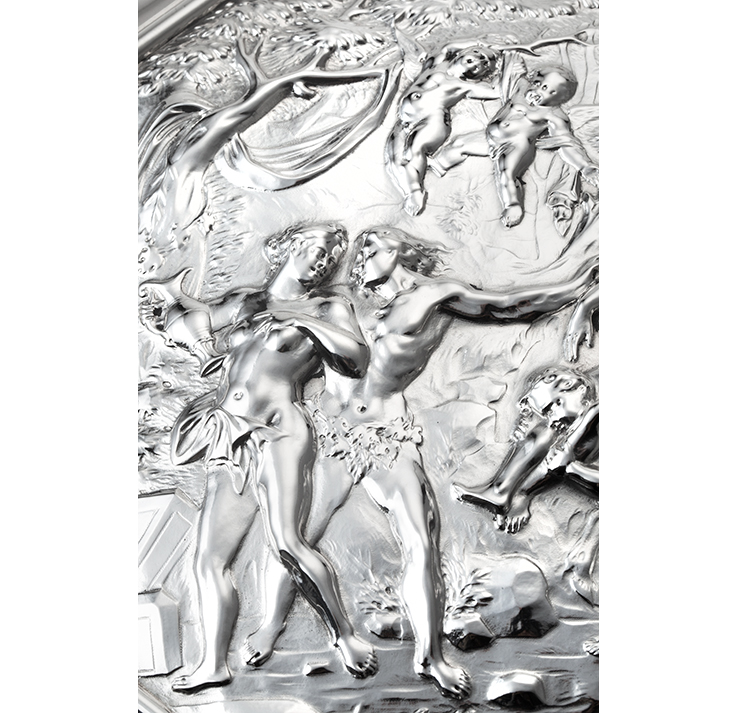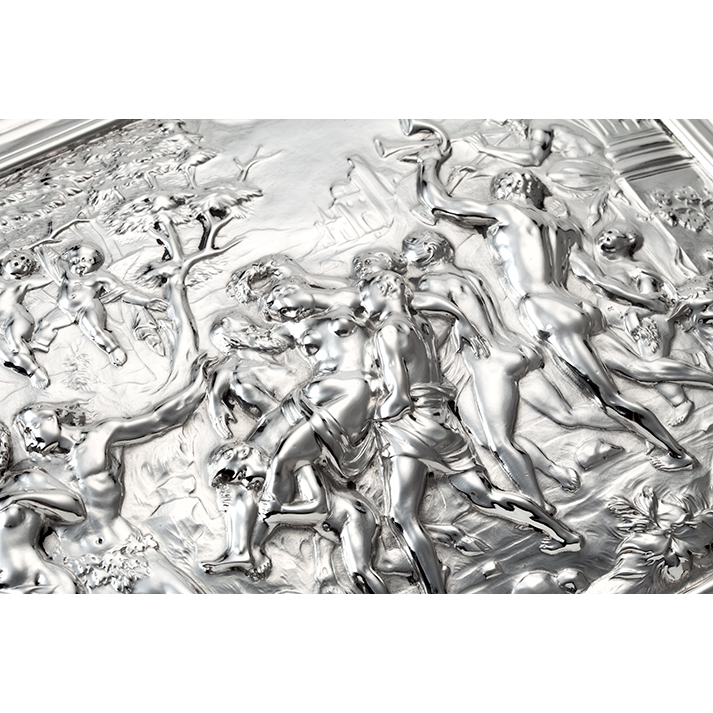
Three silver toilet boxes embossed with mythological scenes
About This Project
Three silver toilet boxes embossed with mythological scenes
Willem Roukens (Willem Rockus)
(Nijmegen/Wesel), late 17th century
1281-, 326- en 320 grams
Large box, 26 cm long, 20,5 cm wide, 10 cm high
Oval box 14,5 cm long, 10,5 cm wide, 6,2cm high
The theme that connects the boxes is a mythological subject, namely that of a goddess, who tries to play her male opponent with her charm. The feminine/divine charm fits well as a theme for a toilet set, which after all has the function of ‘making charming’.
At the end of the seventeenth century the three toilet boxes were only struck with the maker’s mark of Willem Roukens (Wilhelm Rockus) (Nijmegen/Wesel) on the underside of the bottom. It is possible that Willem Roukens made these toilet boxes in Nijmegen before he left for Wesel in 1695 or that he made the toilet boxes in Wesel for a family from Nijmegen. The elaborate mythological scenes, in conjunction with the side panels, point to a date of origin towards the end of the seventeenth century. As a Wesel silversmith since 1695, Roukens’ work dated around 1700 shows that he had abandoned the Baroque style features and focused on the new Louis XIV style.
The embossing: The theme connecting the toilet boxes is derived from mythology, a goddess who, with her charm, tries to play her male opponent. These various mythological stories have been used and depicted in art in many ways. The beautifully chased scenes on these toilet boxes tell the story. The silversmith Willem Roukens must have made use of prints with mythological scenes that circulated among silversmiths. Although the sample print for the scene on the rectangular box has not been found in its entirety, there are sample prints for the scenes on both oval boxes and the sides of the three boxes, the so-called friezes. The similarities connect the three toilet boxes and support the assumption that they were part of a toilet service. The chased scenes can be traced back to prints designed by François Duquesnoy and Michel Dorigny.
François Duquesnoy was born in Brussels in 1597 and was a prominent Baroque sculptor who spent much of his life living and working in Rome. He died in Livorno in 1643, on his journey with his brother Jérôme to Paris to work for the French king. François’ father, Jérôme Duquesnoy the Elder, was also an important sculptor in Brussels and must have trained François to some extent before he left for Rome in 1618. François, known to be very knowledgeable, studied many sculptures from the classical era in Rome. His sculpting skills earned him the nickname ‘putti artist’ in his time, which is evident in several of his works, including a plaque in the Rijksmuseum, Amsterdam. Here we see a striking resemblance of the playing putti with a goat and the embossing on the friezes (sides) of Willem Rouckens’ three toilet boxes. The scenes embossed on the lids of the three toilet boxes are based on prints made by Michel Dorigny (1617-1665). Michel was a well-known and talented engraver in Paris. Many prints by him are known and these will also have been known among silversmiths and used as examples. Michel Dorigny engraved the copper plates after works by his father-in-law, Simon Vouet (1590-1649). Michel was married in 1648 to Françoise, Vouet’s daughter. The prints state that the designs are by his father-in-law, Simon Vouet. So actually, the elaborate scenes on the boxes are after Simon Vouet, who was a French painter, trained in Italy. Simon Vouet painted, among other things, religious scenes, portraits and also mythological scenes. He was one of the most important painters at the court of King Louis XIII in Paris and had many contacts with the nobility and high clergy such as Cardinal de Richelieu.
The silversmith: Willem Roukens was born on 23 February 1662 in Nijmegen. He was the son of notary Adriaen Roukens and Gijsberta Gerits. In 1695 he married Catharina Schluitters, who was already a widow at the time. Willem Roukens became a citizen of Wesel in the year of his marriage and did not return to Nijmegen until after 1713. He died in Nijmegen in 1736 and is buried there. It is not known where Willem was apprenticed to learn the craft of silversmithing. This must have been in Nijmegen, because his father will have had relations in Nijmegen as a notary. It is not possible to state with certainty whether Willem Roukens was a member of the Nijmegen silversmiths’ guild. What is known is that he travelled to France, as a 20-year-old, together with a cousin in 1682. This journey would not have lasted for years, as he married in Wesel in 1695. In the meantime, he might have joined the Nijmegen silversmiths’ guild, only to leave for Wesel in 1695 and to be enrolled as a master silversmith in the silversmiths’ guild there. In 1699 he became a member of the guild board as an assay master in Wesel. In 1705 and 1712 he became an ‘Amtsmeister’. It is said that he worked for Elector Johann Wilhelm of the Palatinate in Düsseldorf. During his working life, Willem Roukens was a famous silversmith, who was particularly praised for his chasing skills. A portrait of him is known, engraved by Pieter van der Meulen (1780-1885). The engraving is after a relief by Willem Roukens himself. Pieter van der Meulen’s engraving is depicted in Geschiedenis der Vaderlandsche Schilderkunst by R. van Eynden and F. Van Willigen in 1816.
For more information, click here


